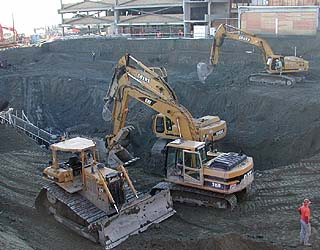
Surveys
Awards
DJC.COM
March 25, 2004
Listen up workers: act quickly on hearing loss
Special to the Journal

Photo by Terry Stephens
Construction workers in Washington are five times more likely to file workers’ compensation claims for hearing loss than workers in all other occupations combined. Even working in the vicinity of ear-damaging noise — like these giant machines — can cause hearing loss.
|
A new state law takes effect Sept. 10, that means workers' compensation claims for permanent job-related hearing losses will have to be filed within a two-year period after the time when a physician determines that loss.
“Before, workers could file claims even 20 years or more after their hearing was damaged by workplace noise,” said Michael Mallahan, a clinical audiologist and director of The Hearing and Balance Lab in Everett.
“Now those claims must be filed in a more timely manner or workers will forfeit their right to the permanent partial disability hearing loss compensation that normally has been paid. A lump sum payment could be $10,000 to $25,000, depending on the degree of hearing loss,” he said.
|
Mallahan is concerned that most workers who would qualify for that compensation are unaware of the coming change.
“Some labor unions are notifying their members but I don't think most workers are aware of it,” he said. “Hearing instruments will still be covered, but the monetary compensation claims will be limited to that two-year window.”
Unfortunately, he said, most workers with hearing losses don't have hearing exams or consider hearing instruments until their family or friends have complained about their hearing problems for years.
“It's common to see patients who have worked for years in construction or other industries and haven't done anything about their hearing loss. When they retire and they're around the house a lot, their wife chides them into getting help,” Mallahan said. “That worked before but it won't after the two-year claim filing limit goes into effect this fall.”
For construction workers, the new law could have a significant impact. The highest incidences of hearing loss are associated with their industry. Nationally, hearing loss claims linked to construction noise have risen nearly 40 percent over the last decade, according to statistics from the National Institute for Occupational Safety and Health.
“That's why OSHA and WISHA are preparing more stringent regulations for the construction industry, including mandating hearing loss prevention programs. Many major companies have those programs but largely they're not available or not used,” said Mallahan, who recently attended a National Hearing Conservation Association conference in Seattle.
| Say what? |
|
According to the National Institute for Occupational Safety and Health, hearing loss from noise is the second most frequently self-reported occupational illness for American workers. For construction workers, hearing loss often begins early in their careers and results in hearing impairment by the age of 50.
In Washington, the permissible exposure limit for an eight-hour shift must average no more than 85 dBA. Workers with a full-shift exposure above that level are required to wear hearing protection devices, have annual tests and receive training on noise exposure and hearing loss prevention. Measured on a decibel scale (dBA), a whisper is about 30 dBA, normal conservation is 60-70 dBA, power tools range between 90-110 dBA, while operating a bulldozer generates sound at 100-112 dBA. If two people at arm’s length have to raise their voices to be heard, the noise around them is above 85 dBA, according to a University of Washington study. Although noise-induced hearing loss is 100 percent preventable with the proper use of hearing protection devices and noise reduction techniques, a WISHA study found construction workers wearing hearing protectors “only a little more than half of the time” that their exposure levels were above 85 dBA, even though more than half of those noise level measurements included exposure to sounds above 115 dBA. Construction workers in all trades examined by the University of Washington study make up only 7 percent of the state’s workforce, yet they file more than 21 percent of all accepted workers’ compensation claims for hearing loss. |
University of Washington associate professor Dr. William Daniell, a speaker at the conference, presented studies of hearing loss claims, noise levels and noise prevention programs in 10 major industries, including the construction industry where bulldozers, excavators, loaders, cranes, jackhammers and lift trucks are in common use.
The report notes that construction workers in Washington state are five times more likely to file workers' compensation claims for hearing loss than workers in all other occupations combined.
“Wearing proper hearing protection is essential. The noise doesn't have to be constant to cause damage. There is a lot of potential harm from infrequent explosive noises. A nail gun can have the same noise level as a shotgun. Hammering or firing a bolt into cement also can put people at risk for serious damage,” Mallahan said.
He's found many instances of workers wearing ear protection only rarely or not at all on construction sites.
“Part of the problem is due to construction workers feeling that wearing ear protection isn't macho or manly so you find a lack of compliance with regulations and hearing prevention programs. They wear eye protection because eye injuries hurt, but hearing losses don't hurt, so workers realize too late that they have damage,” he said.
Mallahan warns workers they also need to consider noises around them as well as their own primary tasks.
“For instance, operators of excavation equipment or graders may be wearing hearing protection but flaggers and workers around the equipment may not be, even though there are dangerous levels of noise affecting them,” he said.
Terry Stephens is a freelance writer based in Arlington. He can be reached by e-mail at features@gte.net.
Other Stories:
- Spiking costs shadow construction market
- Beware of vulnerabilities during construction
- Construction industry struggles to accept ISD
- The roots of Washington's new building code
- Government takes a shine to alternative bids
- New laws have yet to stem tide of condo suits
- Sleep and safety make sound partners
- WSU students train for the Solar Decathlon
- An ACE in the hole for high schoolers
- Do you know who your successor is?
- Six ways to keep your customers happy
- How ergonomics can fatten the bottom line
- More training needed for crane operators
- Shattering the myth of wired glass
- Want big profits? Make yours a high-trust company
- Equipment costs don't have to break the bank
- In a lawsuit? Who's paying the lawyers?
Copyright ©2009 Seattle Daily Journal and DJC.COM.
Comments? Questions? Contact us.